Now in its seventh generation, the latest Trek Madone SLR is claimed to be both faster and lighter than ever.
Yet while this latest version retains a typically Madone-esque silhouette, it’s impossible to miss the bike’s unique selling point – the big hole in the seat tube, or IsoFlow, as Trek calls it.
IsoFlow might seem like the main story here, but it isn’t the only thing worth paying attention to.
Overall, the Trek Madone SLR 7 builds on the highly refined Madone platform.
Trek has brought the bike up to date and taken into account the latest aero trends. That's one of the reasons it earns a place in our 2023 Aero Road Bike of the Year category.
While the results are thoroughly impressive on the road, there's no ignoring the high cost of entry, especially on a build with some nominally mid-range parts.
Trek Madone SLR 7 Gen 7 frameset
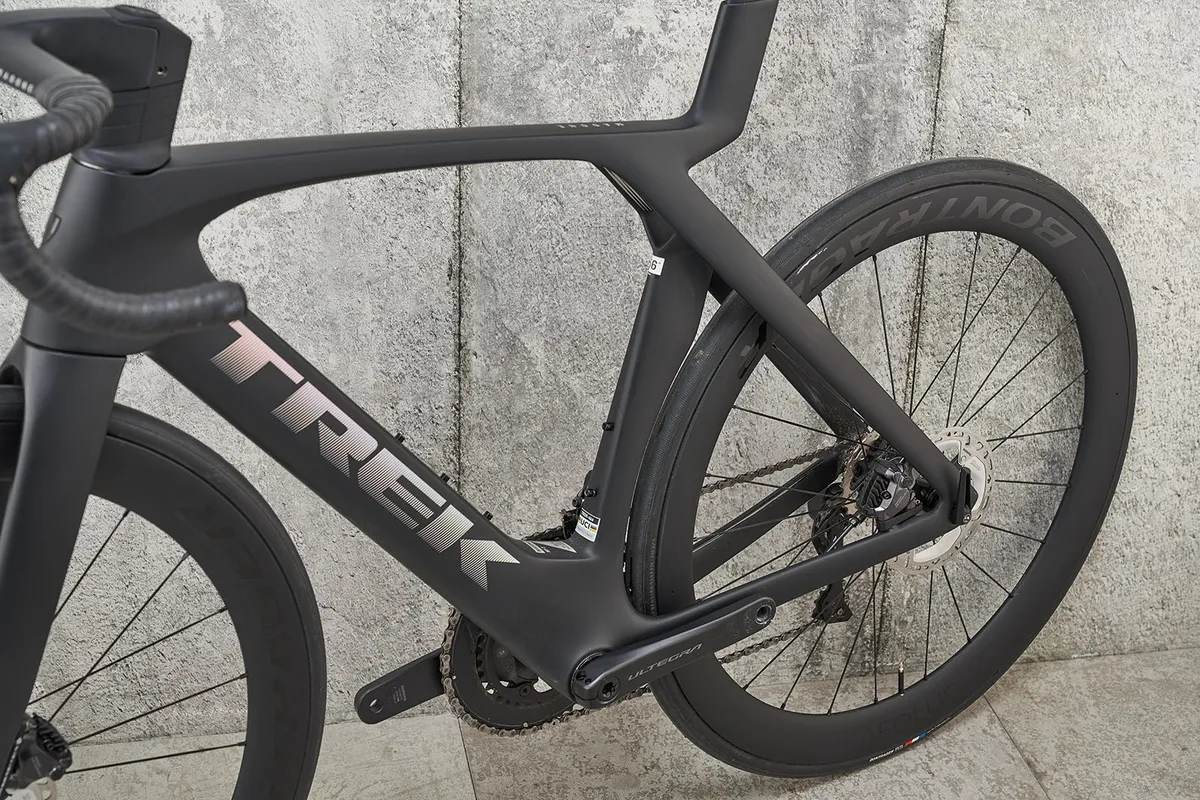
Unsurprisingly, pro-rider feedback about the previous Madone SLR was simply that those who rode it wanted the new one to be “faster and lighter”.
Starting with the subtler changes, Trek has updated its signature Kammtail Virtual Foil tube shapes (or truncated aerofoils, as everyone else calls them) and overhauled the front end, adding a lighter, fully integrated aero cockpit with flared drops.
Trek also says the handlebar’s narrow hood position plays a significant role in making the bike and rider more aerodynamic.
More noticeably, though, Trek has replaced the comfort-enhancing IsoSpeed system at the junction of the seat tube and top tube with a kite-shaped hole it calls ‘IsoFlow’.
Given most riders, pro or otherwise, apparently didn’t make frequent use of IsoSpeed’s adjustability, Trek opted to replace it with a simpler and lighter solution.
According to Trek, IsoFlow is both lighter and more aerodynamic than IsoSpeed.
Rear-end compliance is claimed to hit the same level as before (with the adjustable IsoSpeed set to its stiffest setting), because the seatpost is essentially cantilevered over the rear of the bike.
Overall, IsoFlow is a win-win solution, Trek says.

The sum of these changes is a bike that’s claimed to be 300g lighter for a complete bike. It’s not a night-and-day difference, but a nice saving nonetheless.
My size-56cm Madone SLR 7 weighs 7.69kg. While that’s slightly lighter than some similarly specced competitors, such as the Giant Propel Advanced Pro 0 AXS and Cervélo S5, there are lighter aero bikes available for similar money.
The top-spec Canyon Aeroad CFR we tested in 2020, for example, weighed just 7.3kg (size medium). At the time of writing, the 2023 version costs £8,799, yet is specced with a Dura-Ace Di2 R9200 groupset.
In terms of speed, the new Madone is claimed to be 19 watts more aerodynamically efficient at 45kph than the previous one, with a rider on board.
This, Trek says, translates to a time saving of around “60 seconds per hour”, meaning a ride that would take an hour on the old Madone should only take 59 minutes on the new one. That’s an impressive saving for a racer, if the claims are to be believed.
Trek Madone SLR 7 Gen 7 geometry
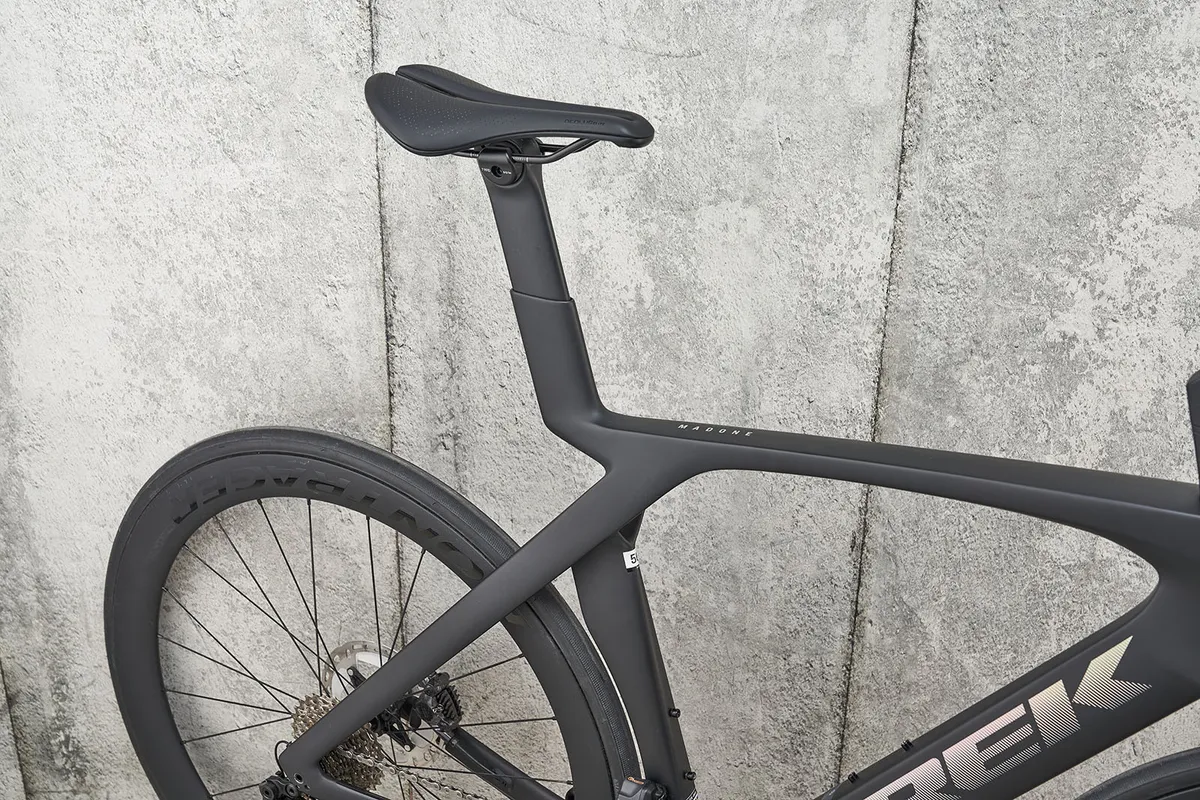
In terms of fit, the Madone SLR uses Trek’s H1.5 geometry (as seen on the latest Emonda SLR) – a halfway house between the aggressive H1 and more relaxed H2 geometries it offered previously.
Helpfully, there are eight frame sizes in total, from 49cm to 62cm, meaning a wide range of riders should be able to find a well-fitting bike, too.
Overall, though, the measurements and angles are still very race-focused.
Stack and reach sit at 563 and 391mm respectively, almost identical to key competitors such as the latest Giant Propel and the Cervélo S5.
The head tube and seat tube angles (on my size-56cm test bike) are both relatively steep, at 73.5 and 73.3 degrees, respectively. It also has a short, 58mm trail and a tight wheelbase of just 983mm.
All of which points towards nimble, reactive handling and a riding position designed to encourage you into an aerodynamic riding position.
| | 47 | 50 | 52 | 54 | 56 | 58 | 60 | 62 |
|---|---|---|---|---|---|---|---|---|
| Seat angle (degrees) | 74.6 | 74.6 | 74.2 | 73.7 | 73.7 | 73 | 72.8 | 72.5 |
| Head angle (degrees) | 72.1 | 72.1 | 72.8 | 73 | 73.5 | 73.8 | 73.9 | 73.9 |
| Chainstay (mm) | 410 | 410 | 410 | 410 | 410 | 411 | 411 | 412 |
| Seat tube (mm) | 424 | 453 | 483 | 496 | 525 | 553 | 573 | 593 |
| Top tube (mm) | 512 | 521 | 534 | 543 | 559 | 574 | 586 | 598 |
| Head tube (mm) | 100 | 111 | 121 | 131 | 151 | 171 | 191 | 211 |
| Fork offset (mm) | 45 | 45 | 45 | 45 | 40 | 40 | 40 | 40 |
| Trail (mm) | 68 | 62 | 58 | 56 | 58 | 57 | 56 | 56 |
| Bottom bracket drop (mm) | 72 | 72 | 72 | 70 | 70 | 68 | 68 | 68 |
| Wheelbase (mm) | 972 | 974 | 977 | 981 | 983 | 992 | 1,001 | 1,010 |
| Standover (mm) | 692 | 711 | 732 | 744 | 768 | 793 | 811 | 829 |
| Stack (mm) | 507 | 521 | 533 | 541 | 563 | 581 | 601 | 620 |
| Reach (mm) | 373 | 378 | 383 | 380 | 391 | 396 | 399 | 403 |
Trek Madone SLR 7 Gen 7 build
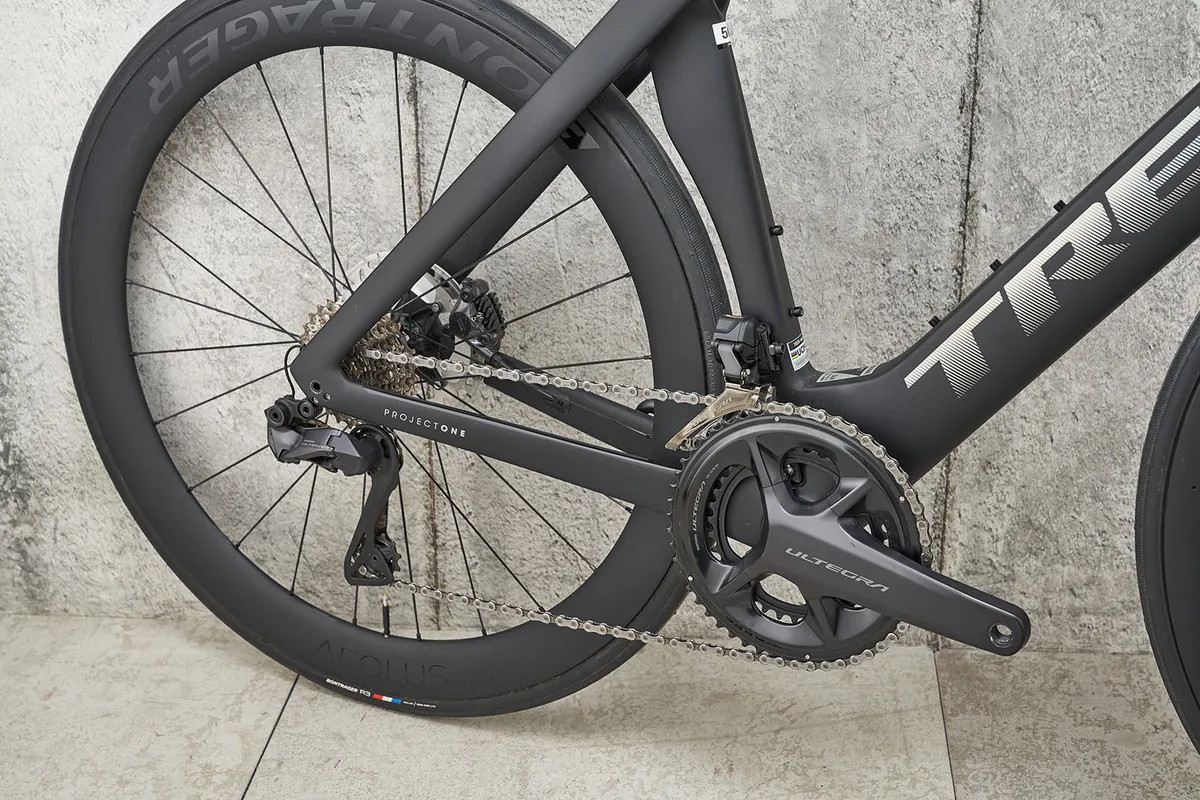
Despite the five-figure price tag, the build encompasses a suite of parts that are nominally mid-range (or would have been before the great bike industry price hikes of recent years).
You get Shimano’s Ultegra Di2 8100 groupset, instead of Dura-Ace Di2, for example. The wheelset is the mid-range carbon Bontrager Aeolus Pro 51, instead of the top-tier Aeolus RSL.
Trek has specced Bontrager R3 Hard-Case Lite clincher tyres (in a size 700x25c), instead of the pricier tubeless-ready versions or the beautiful (and even more expensive) R4 320 Handmade cotton clinchers.
A Bontrager Aeolus Elite saddle, with ‘Austenite’ (a type of steel alloyed with nickel) rails is chosen, rather than the Pro or RSL models with carbon rails.

You don’t get a power meter with Shimano builds, either. SRAM builds come with Quarq power meters as standard, though are a little more expensive as a result.
This ‘mid-range’ kit mostly performs excellently, though, and one could argue upgrading these parts to the fancier, lighter versions is only going to offer marginal gains at even greater expense (that’s what the £13,500 Madone SLR 9 offers).
However, when you consider some of the best aero bikes are available with equivalent specs for significantly less money, it’s a tough pill to swallow.
Still, Trek is far from the only brand making expensive bikes these days.
Whether it’s the Specialized S-Works Tarmac SL7, Pinarello Dogma F or Colnago V4Rs, to name three, there are certain bikes that aren’t focused on value first and foremost, and that’s okay.
Though an important factor in any purchasing decision, value won’t be the only consideration for everyone, after all.
Trek isn’t cutting any corners with the most important aspect of the bike, either – the SLR frameset and integrated handlebar are exactly the same as those used to compete at the highest level.
Like my colleague, Ashley Quinlan, who reviewed the Madone SLR 9 eTap last year, I came away impressed by the Madone’s front-end.
As already noted, the new handlebar features a slightly narrower, 39cm (centre to centre) hoods position, while it flares out to 42cm wide at the drops.
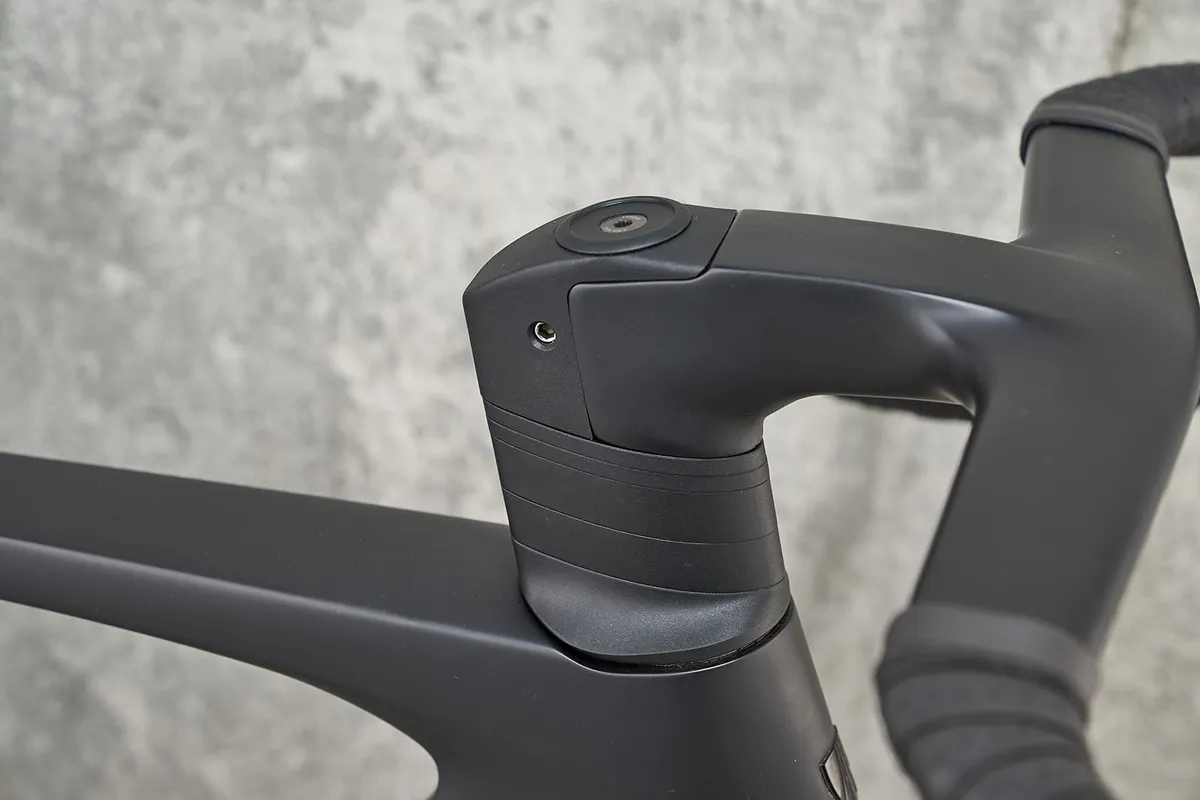
This gives you the aerodynamic gain of a narrower handlebar at the hoods, with the wider drops providing additional control and leverage for descending and sprinting.
It’s nowhere near as extreme as the 33/37cm handlebar featured on the Ribble Ultra SL R I tested just prior to the Madone, which inevitably means the gain isn’t as obvious. However, it’s certainly a less intimidating change for those not used to riding with narrow handlebars.
All things considered, it’s a positive change, with no notable compromises to comfort or handling.
There are 11 different stem-length and handlebar-width combinations available, and Trek says a dealer can swap a handlebar size at the point of purchase for no extra cost.
Alternatively, it’s also possible to run a standard, 1 1/8in stem and any handlebar you like, giving you near-limitless options for front-end customisation.
My only real disappointment was my test bike’s drab matt black paintjob.
Trek is renowned for producing some of the peloton’s best paintjobs in recent years, yet, save for the cool reflective down tube logo, this one is about as dull as they come.
Of course, others might feel differently and, either way, there are other choices available, plus the option for a custom paintjob through Trek’s Project One programme (at additional expense).
Trek Madone SLR 7 Gen 7 ride impressions
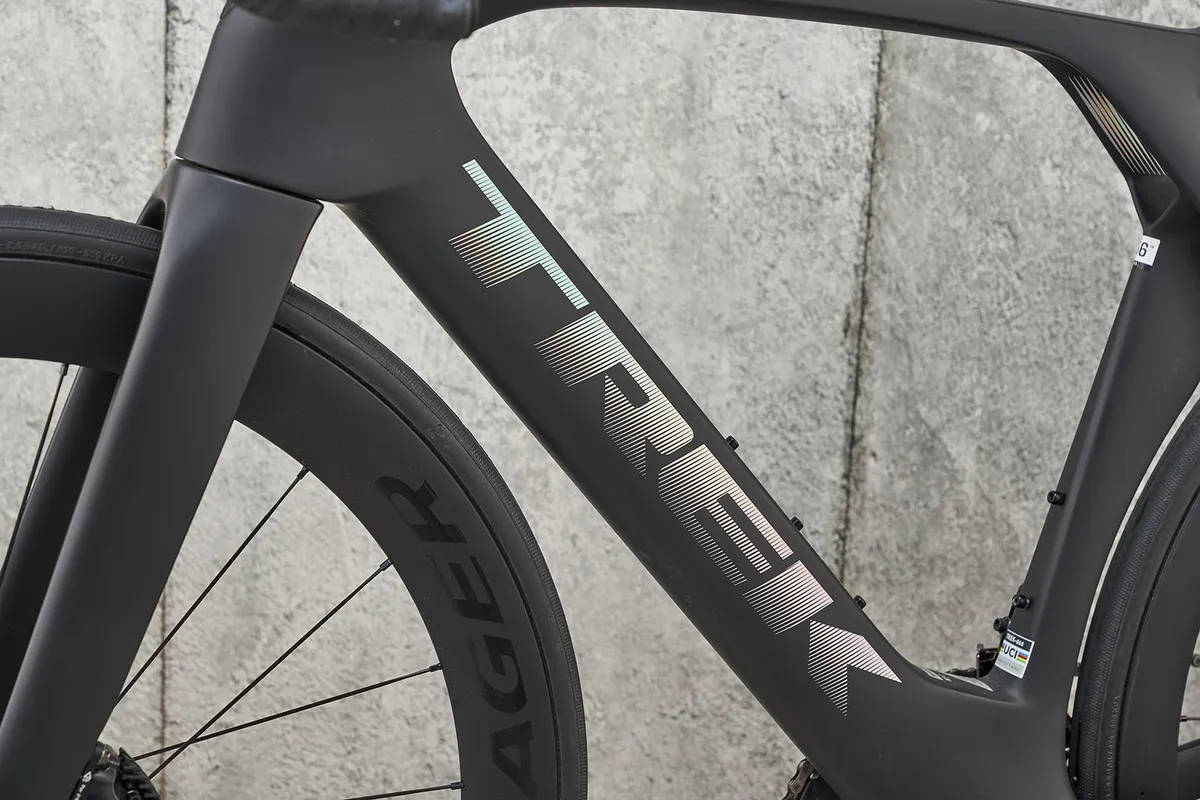
The Madone’s greatest strength is that it manages to feel like a non-aero bike, but faster.
It barrels along on flat or rolling roads, yet feels snappy and energising when you start climbing or rise out of the saddle to sprint over a brow.
I can’t say whether IsoFlow makes the Madone any faster, but it certainly makes for a comfortable rear end when paired with the excellent Bontrager Aeolus saddle (a firm favourite among many testers at BikeRadar).
It's obvious enough to make the handlebar feel fairly stiff in contrast, in fact.
As expected, Shimano’s latest Ultegra Di2 groupset (here with suitably sporty, 52/36-tooth chainrings and an 11-30-tooth cassette) offers near-faultless performance, albeit at a slightly heavier overall weight than Dura-Ace.
The latest Shimano hydraulic brakes, with burly 160mm rotors front and rear, make the Madone a great partner on descents, too.

Despite the quick handling and short wheelbase, there’s no hint of instability at high speeds.
The Bontrager Aeolus Pro 51 wheels also impress. At a claimed 1,590g for the pair, they don’t feel cumbersome when climbing steep pitches, yet the 51mm-deep rims provide a noticeable performance benefit on the flats.
A 23mm internal rim width also helps provoke extra volume out of the 25c tyres, which inflate to 28.5mm wide at 65psi/4.5 bar.
With an external rim width of 30mm, Trek likely opted for 25c tyres (rather than 28c or larger tyres as many brands now do) to optimise the aerodynamic performance of the combination.
On good-quality roads, this combination doesn’t pose any issues, but I did find myself wanting for greater tyre volume whenever my test rides took a turn down a broken lane.
Fortunately, there’s plenty of scope to size up, if you want more cushioning or grip.
Frame and fork clearance is rated for up to 28c tyres (which would likely measure around 30mm wide on the Bontrager rims), but the space around both front and rear tyres suggests that’s a conservative estimate.
My main issue in this area, though, is the stock Bontrager tyres offer only average performance.

Grip levels are good, but rolling speed isn’t competitive with the best road bike tyres, and the ride feel is disappointingly wooden too.
The latter two points can be attributed partly to the basic butyl inner tubes supplied as stock.
Upgrading to latex or TPU inner tubes would doubtless go some way to improving both, but it’s also fair to say these tyres won’t ever get the most out of this bike no matter what you put in them.
That Trek is charging £10,200, yet skimping on something as critical as tyres, is disappointing.
Replacing them would be relatively easy and inexpensive, of course (and you could go tubeless too, with the addition of tubeless rim tape, valves and sealant for the wheels), but you shouldn’t have to when you’ve spent this much money.
Trek Madone SLR 7 Gen 7 bottom line
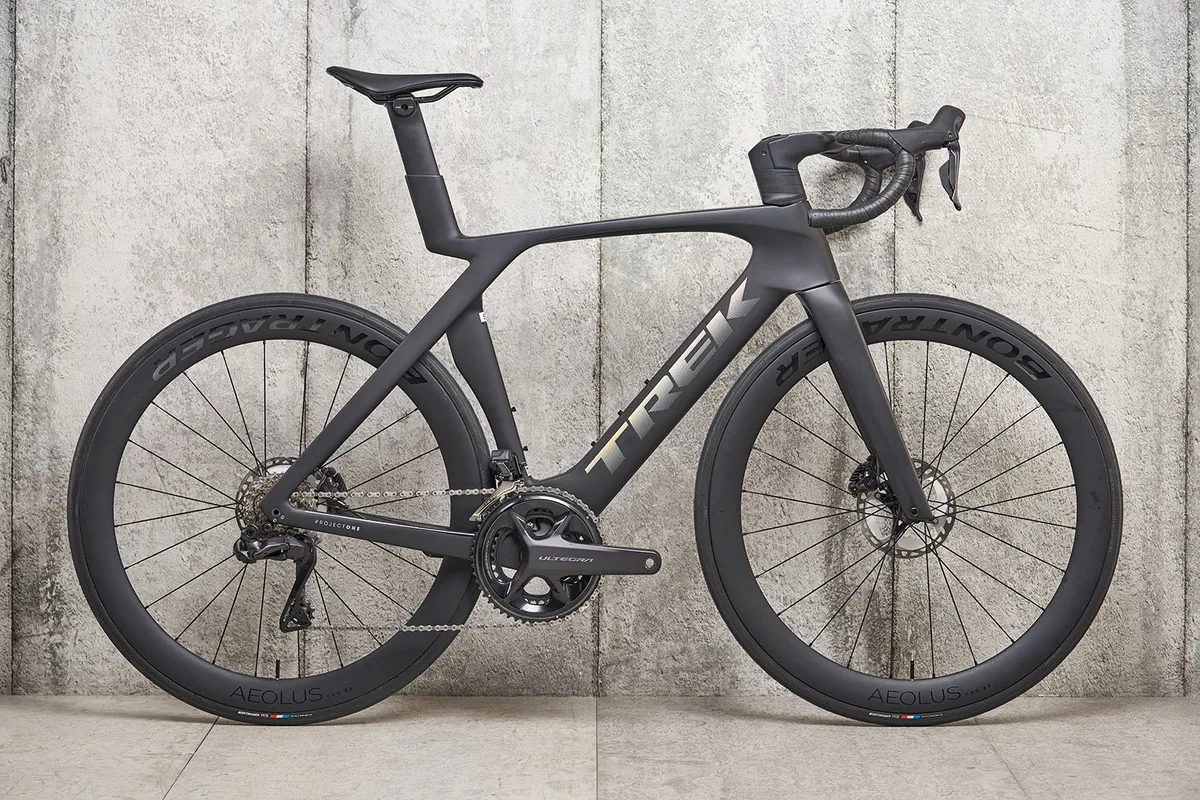
The Trek Madone SLR 7 manages to combine the fun and engaging ride quality of a normal race bike with the speed of an aero bike.
It would be a fantastic companion for racing or fast group rides, yet is comfortable enough for big days in the saddle, too.
Though technically mid-range, the parts and components offer excellent all-round performance (tyres and inner tubes aside). Even so, it’s still hard to ignore the fact there are many similarly specced competitors available that cost far less.
However, if you want a super-fast road bike that pushes the boundaries of aerodynamic design and says ‘Trek’ on the down tube, the Madone SLR doesn’t disappoint.
Aero Road Bike of the Year 2023 | How we tested
If you’re trying to ride faster, then aerodynamic drag is usually your biggest problem.
Previously, though, picking a dedicated aero road bike meant compromising on things such as comfort and practicality. Fortunately, such issues are (largely) problems of the past.
Today’s aero bikes are fast on the flats and no slouches up hills either. Most now include clearance for wide tyres and the best have front ends that don’t require a degree in mechanical engineering to work on.
With that in mind, we put the contenders to the test on the twisty, technical and rolling hills of south Bristol.
As with all road bikes, we considered how easy each bike is to live with, and how easily the stock setup can be adjusted to suit your personal needs and riding style.
Many of the bikes featured in this year’s Aero Road Bike of the Year test are at the upper end of the pricing scale, with premium groupsets and parts showcasing the best contemporary equipment. However, most are also available in cheaper specs if your budget doesn’t stretch as far.
Our Aero Road Bike of the Year contenders
- 3T Strada ICR Force eTap AXS
- Giant Propel Advanced Pro 0 AXS
- Ribble Ultra SL R Enthusiast
- Trek Madone SLR 7
Thanks to…
Thanks to our sponsors, Lazer, FACOM tools and Band Of Climbers for their support in making Bike of the Year happen.
Product
| Brand | trek |
| Price | 13300.00 AUD,10999.00 EUR,10200.00 GBP,9050.00 USD |
| Weight | 7.6900, KILOGRAM (56cm) - |
Features
| Fork | Trek Madone SLR (Gen 7) |
| br_stem | Madone integrated stem |
| br_chain | Shimano CN-M8100, 12-speed |
| br_frame | Trek Madone SLR (Gen 7) |
| Tyres | Bontrager R3 Hard-Case Lite |
| br_brakes | Shimano Ultegra R8170 hydraulic disc with Shimano RT-MT800 rotors |
| br_cranks | Shimano Ultegra Di2 R8170 |
| br_saddle | Bontrager Aeolus Elite |
| br_wheels | Bontrager Aeolus Pro 51 |
| br_shifter | Shimano Ultegra Di2 R8170 |
| br_cassette | Shimano Ultegra R8100, 11-30T |
| br_seatpost | Trek Madone SLR |
| br_gripsTape | Bontrager Supertack Perf tape |
| br_handlebar | Madone integrated handlebar |
| br_bottomBracket | Praxis T47 |
| br_availableSizes | 47, 50, 52, 54, 56, 58, 60, 62cm |
| br_rearDerailleur | Shimano Ultegra Di2 R8100 |
| br_frontDerailleur | Shimano Ultegra Di2 R8100 |

